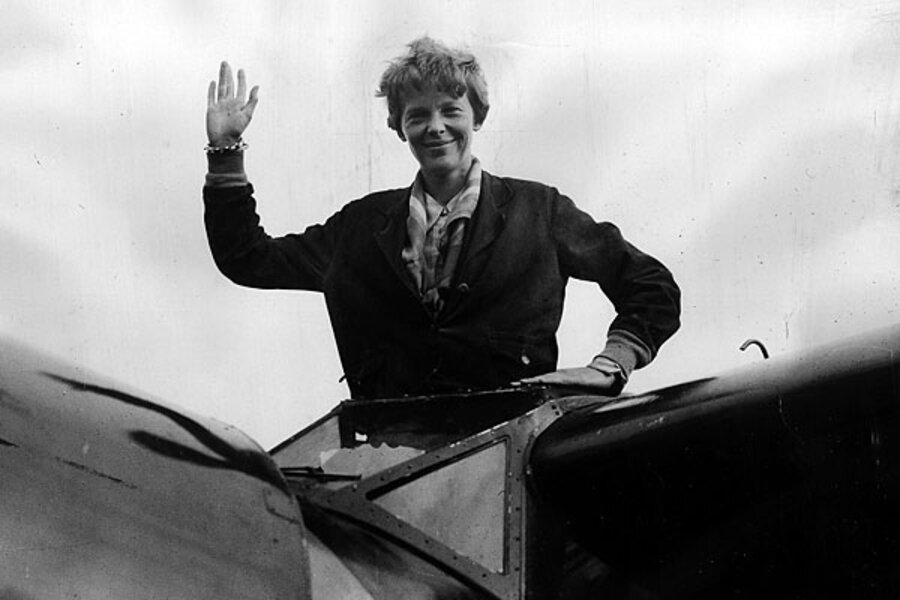Amelia Earhart mystery solved? South Pacific bones may have answers.
Loading...
| NORMAN, Oklahoma
The three bone fragments turned up on a deserted South Pacific island that lay along the course Amelia Earhart was following when she vanished. Nearby were several tantalizing artifacts: some old makeup, some glass bottles and shells that had been cut open.
Now scientists at the University of Oklahoma hope to extract DNA from the tiny bone chips in tests that could prove Earhart died as a castaway after failing in her 1937 quest to become the first woman to fly around the world.
"There's no guarantee," said Ric Gillespie, director of the International Group for Historic Aircraft Recovery, a group of aviation enthusiasts in Delaware that found the pieces of bone this year while on an expedition to Nikumaroro Island, about 1,800 miles (2,900 kilometers) south of Hawaii.
IN PICTURES: Female pilots in World War II
"You only have to say you have a bone that may be human and may be linked to Earhart and people get excited. But it is true that, if they can get DNA, and if they can match it to Amelia Earhart's DNA, that's pretty good."
It could be months before scientists know for sure — and it could turn out the bones are from a turtle. The fragments were found near a hollowed-out turtle shell that might have been used to collect rain water, but there were no other turtle parts nearby.
Earhart's disappearance on July 2, 1937, remains one of the 20th century's most enduring mysteries. Did she run out of fuel and crash at sea? Did her Lockheed Electra develop engine trouble? Did she spot the island from the sky and attempt to land on a nearby reef?
"What were her last moments like? What was she doing? What happened?" asked Robin Jensen, an associate professor of communications at Purdue University in Indiana who has studied Earhart's writings and speeches.
Since 1989, Gillespie's group has made 10 trips to the island, trying each time to find clues that might help determine the fate of Earhart and her navigator, Fred Noonan.
Last spring, volunteers working at what seemed to be an abandoned campsite found one piece of bone that appeared to be from a neck and another unknown fragment dissimilar to bird or fish bones. A third fragment might be from a finger. The largest of the pieces is just over an inch long.
The area was near a site where native work crews found skeletal remains in 1940. Bird and fish carcasses suggested Westerners had prepared meals there.
"This site tells the story of how someone or some people attempted to live as castaways," Gillespie said Friday in an interview with The Associated Press. "These fish weren't eaten like Pacific Islanders" eat fish.
Millions of dollars have been spent in failed attempts to learn what happened to Earhart, declared dead by a California court in early 1939.
The official version says Earhart and Noonan ran out of fuel and crashed at sea while flying from Lae, New Guinea, to Howland Island, which had a landing strip and fuel.
Gillespie's book "Finding Amelia: The True Story of the Earhart Disappearance," and "Amelia Earhart's Shoes," written by four volunteers from the aircraft group, suggest the pair landed on the reef and survived, perhaps for months, on scant food and rainwater.
Gillespie, a pilot, said the aviator would have needed only about 700 feet (200 meters) of unobstructed space to land because her plane would have been traveling only about 55 mph (90 kph) at touchdown.
"It looks like she could have landed successfully on the reef surrounding the island. It's very flat and smooth," Gillespie said. "At low tide, it looks like this place is surrounded by a parking lot."
However, Gillespie said, the plane, even if it landed safely, would have been slowly dragged into the sea by the tides. The waters off the reef are 1,000 to 2,000 feet (300 to 600 meters) deep. His group needs $3 million to $5 million for a deep-sea dive.
The island is on the course Earhart planned to follow from Lae, New Guinea, to Howland Island, which had a landing strip and fuel. Over the last seven decades, searches of the remote atoll have been inconclusive.
After the latest find, anthropologists who had previously worked with Gillespie's group suggested that he send the bones to the University of Oklahoma's Molecular Anthropology Laboratory, which has experience extracting genetic material from old bones. Gillespie's group also has a genetic sample from an Earhart female relative for comparison with the bones.
The lab is looking for mitochondrial DNA, which is passed along only through females, so there is no need to have a Noonan sample.
Cecil Lewis, an assistant professor of anthropology at the lab, said the university received a little more than a gram of bone fragments about two weeks ago. If researchers are able to extract DNA and link it to Earhart, a sample would be sent to another lab for verification.
"Extraordinary claims require extraordinary evidence. That's why we're trying to downplay a lot of the media attention right now," Lewis said. "For all we know, this is just a turtle bone, and a lot of people are going to be very disheartened."
Under the best circumstances, the analysis would take two weeks. If scientists have trouble with the sample, that time frame could stretch into months, Lewis said.
"Ancient DNA is incredibly unpredictable," he said.





